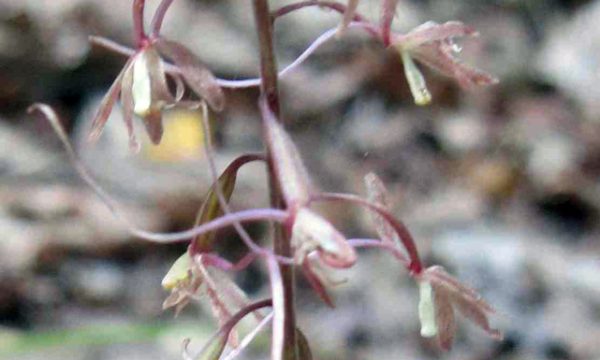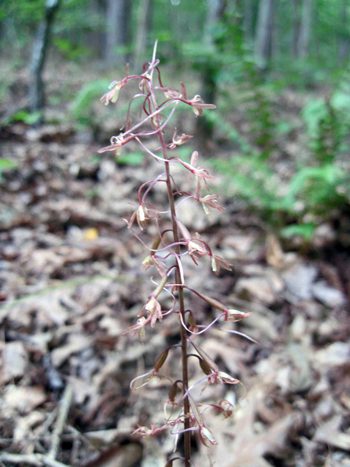Crane-fly orchid: Nature’s Plain Jane flower

While walking on my grandparents’ property last week, I was fortunate to stumble upon one of the most common and understated orchids in bloom – the Crane-fly orchid (Tipularia discolor). We typically think of orchids as something rare and eye-catching, with vibrant colors that stand out vividly from a woodland backdrop. The Crane-fly orchid, however, is so small it is easy to miss, even when you are looking specifically for it. Its delicate blooms resemble a specific long-legged insect from which it derives its name.
Crane-fly orchids, also known as crippled crane-fly or elfin spur, are a perennial terrestrial woodland orchid and the only species in its genus found in North America. They typically grow in rich soils near streams and in deciduous forests, such as oak hickory, or also in mixed hardwood pine forests.
The Crane-fly orchid is probably the only orchid where the leaf is arguably more showy than the bloom. Each individual plant has only one leaf, which is bright green and shiny on top, usually with a sort of bumpy or uneven surface, and deep purplish-burgundy on the underside. The leaves emerge in late fall and disappear in spring, so there is no leaf when they are blooming.
 The Crane-fly orchid’s bloom time is July to September. It has a single flowering stem that typically grows to a height of 15 to 20 inches. The blooms are delicate and spindly, almost wispy, and their color is very earthy – a sort of transparent, pinkish-brown, so it’s no wonder they are easy to miss. I spotted the nondescript beauties on our property a few days before, but was without my camera. I had a difficult time locating them again for photographing.
The Crane-fly orchid’s bloom time is July to September. It has a single flowering stem that typically grows to a height of 15 to 20 inches. The blooms are delicate and spindly, almost wispy, and their color is very earthy – a sort of transparent, pinkish-brown, so it’s no wonder they are easy to miss. I spotted the nondescript beauties on our property a few days before, but was without my camera. I had a difficult time locating them again for photographing.
They are pollinated by noctuid moths (who feed at night) and equipped with a specialized structure called “pollinaria,” which is basically a mass of pollen granules. The flowers of the Crane-fly orchid are asymmetrical, twisted to the right and left (giving them the look of an injured or “crippled” crane-fly), such that the pollinaria attaches to the eyes of moths that is then deposited onto another orchid.
Although relatively common here, they are listed as rare, threatened or endangered in five states: Florida, Massachusetts, Michigan, New York and Pennsylvania. Despite their relative abundance in North Carolina, they don’t grow just anywhere. A loss of hardwood forest habitat has certainly contributed to their decline in many places.
So although they aren’t exceedingly rare or particularly showy, they are an indicator of a quality habitat, and I was particularly happy to find them on our family’s land. I take pleasure in the idea that these Crane-fly orchids were likely here when my great-grandparents walked these woods, and I hope they will be around for many more generations of grandkids and great-grandkids to find.